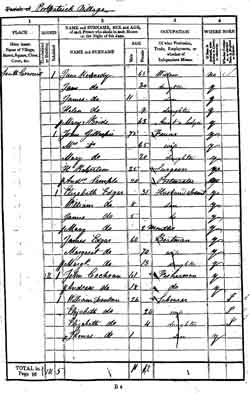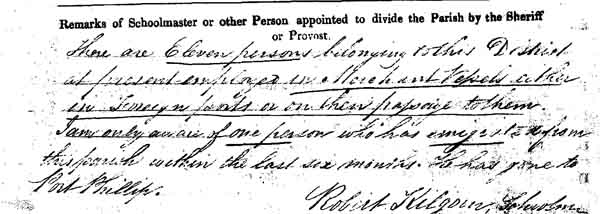1841 Census
1841 Census
The 1841 Census was taken on Sunday 6 June under provisions in the Census Act 1840 (3 & 4 Vict c.99) and Census Amendment Act (4 & 5 Vict, c.7). In Scotland enumeration duties were carried out by the official schoolmaster in each parish and the sheriff deputes (for counties and stewartries) and provosts (for burghs).
The population of Scotland on 6 June 1841 was 2,620,184.
This guide covers:
1841 Census Questions
The 1841 Census is the earliest to provide details for the whole population. It contains less information than later censuses but is a helpful reference point for research in the Old Parish Registers. The main points to note are that:
- you will find the name and occupation of each person but not their marital status
- head of household (and thus relationship to the head of household) are not recorded
- ages are rounded down to the nearest five for anyone over 15 years of age although this instruction wasn't always followed as illustrated in the example below
- information about place of birth is less helpful than in later censuses and is given as:
- yes if the person was born in the county
- no if born elsewhere in Scotland
- E if born in England
- I if born in Ireland
- F if foreign born
- soldiers and sailors who were ashore were enumerated at their place of residence.
This example is from the 1841 Census for Portpatrick in Wigtownshire (our reference 1841/896/10, page 16).
Click on the image to view it full size.
One resident was born outside the county and three were born in Ireland (I). You can see ticks beside these entries presumably added when the enumerator did a tally for his statistical return.
Some of the ages have been rounded down to the nearest five as instructed but other entries give the actual age.
In this extract from the 1841 Census for the village of Elie in Fife (our reference 1841/427/3, page 42) the schoolmaster, Robert Kilgour, comments that he knows of eleven persons who were at sea on census night and of one person who had emigrated in the past six months.
Missing 1841 Census Records
In 1910 the Registrar General for Scotland found the original 1841 and 1851 Census enumeration books in a storage area in Whitehall and arranged for them to be transferred to Edinburgh for permanent preservation at New Register House.
Several of the original volumes have not survived. They are mainly for parishes in Fife and it is said that they were lost when being transferred across the River Forth but there is no documentary evidence to support this. The missing records are listed below:
- 326 - Abernethy: the enumeration book for people living in Fife
- 400 - Abdie
- 404 - Arngask: - the enumeration book for people living in Fife
- 406 - Auchtermuchty
- 409 - Balmerino
- 415 - Ceres
- 416 - Collesie
- 418 - Creich
- 419 - Cults
- 420 - Cupar
- 421 - Dairsie
- 423 - Dunbog
- 434 - Kennoway - only the enumeration book for Markinch has survived
- 439 - Kinghorn
- 440 - Kinglassie
- 442 - Kirkcaldy
- 444 - Leslie
- 577 - Auchinleck, Ayrshire
There are no enumeration books for the following because the civil parish wasn’t included as a census division in 1841.
- 93 - Cromdale, Moray - entries can be found under Inverallan
- 167 - Seafield, Banffshire - started 1861
- 324 - Aberfeldy, Perthshire
- 367 - Kinloch Rannoch, Perthshire - started 1861
- 509 - Cumlodden, Argyllshire - started 1861
- 535 - Tarbert, Argyll
- 556 - Lochranza, Bute see Kilmory
- 557 - North Bute, Bute
- 776 - Kirkhope, Selkirkshire - started 1861
- 809 - Teviothead, Roxburghshire
- 862 - Corsock Bridge, Kirkcudbrightshire - started 1861
- 864 - Dalbeattie, Kirkcudbrightshire - started 1861 - see Urr
1841 Census Street Indexes
Census street indexes provide parish or registration district (RD) and enumeration district (ED) references for each street in a city or urban area. They also cover institutions such as asylums, hospitals, workhouses, prisons, police stations and barracks as well as hotels and public buildings.
There are only two street indexes for the 1841 Census. They have been digitised and are made available as pdf files that are several megabytes in size.
If you can’t find a particular street it may not have existed in 1841 or may have had a different name.

